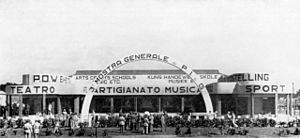Hendrik Prinsloo facts for kids
Quick facts for kids
Hendrik Prinsloo, OBE, ED
|
|
|---|---|
| Birth name | Hendrik Frederik Prinsloo |
| Born | 18 August 1890 Carolina, South African Republic (now Mpumalanga) |
| Died | 20 November 1966 (aged 76) Ermelo, Transvaal, South Africa |
| Allegiance | |
| Service/ |
South African Army |
| Rank | Colonel |
| Unit | Regiment Botha |
| Commands held | Zonderwater prisoner of war camp |
| Battles/wars | South West Africa 1914 1916 France 1922 Bondelswarts Rebellion |
| Awards | OBE, ED, Croix de Guerre avec Palmes, Mentioned in dispatches |
| Relations | Stephanie Cecilia Weidner, d. 19 November 1941 (two children) Grace Madeleine Sedgwick |
| Other work | Farming, provincial politics |
Hendrik Frederik Prinsloo (born August 18, 1890 – died November 20, 1966) was a brave South African army officer. When he was just 12 years old, he was held in a concentration camp by the British during the Anglo-Boer War. However, he later fought alongside the British in the South African forces during both World Wars. He is most remembered for how kindly he managed the Zonderwater Italian prisoner of war camp as its commandant.
Contents
Early Life and Challenges
Hendrik Prinsloo was born in 1890. His father, also named Hendrik Frederik Prinsloo, was a commandant who led the Carolina Boer Commando. Sadly, his father died in battle in 1900.
During the Second Boer War, when Hendrik was only 12, he was captured by the British. He was carrying weapons with his father's commando. Because he was so young, he was sent to a concentration camp in Barberton with his mother.
After the war, he worked as an interpreter in a court. Later, he became a farmer in the Carolina area.
Military Service and Wars
In 1914, during the Boer Revolt, Prinsloo supported the South African government. He became an "honorary lieutenant" in the army. He served in German South West Africa and was an assistant to a senior officer.
He also served in France during World War I, likely with the South African Brigade. He was even awarded the French Croix de Guerre for his bravery.
After World War I, he left the army for a while and joined the police force. In 1922, as a lieutenant, he played a key role in ending the Bondelswarts Rebellion in South West Africa. He led the group that found the rebel leader, which helped end the fighting.
When World War II began, Prinsloo was the Commanding Officer of the Regiment Botha. He was supposed to go to North Africa with his regiment. However, the Prime Minister, Field Marshal JC Smuts, asked him to take charge of a very large Italian prisoner of war camp called Zonderwater.
In 1947, he represented South Africa at a meeting in Geneva. This meeting was to update the rules for how prisoners of war should be treated, known as the Geneva Convention.
Leading the Zonderwater POW Camp
In 1942, Colonel Prinsloo became the assistant camp commandant of the Zonderwater prisoner-of-war camp. The next year, he was promoted to acting colonel.
Zonderwater was not just a camp; it was like a small city. It was the biggest of the Italian POW camps during World War II. At its peak, it held almost 100,000 prisoners. Colonel Prinsloo's leadership made Zonderwater one of the best-run military camps in South Africa.
He worked hard to improve the living conditions for the prisoners. He helped set up an orchestra and a library with 10,000 books. There were also craft shows and art classes. Because of his efforts, the number of prisoners who couldn't read or write dropped from 30% to just 2%. Colonel Prinsloo truly cared for the prisoners, making their lives at Zonderwater as close to normal as possible.
Awards and Honors
For his service in World War I, Prinsloo received the French Croix de Guerre. He was also Mentioned in Despatches, which means his bravery was officially recognized.
In 1944, he received the Efficiency Decoration. In 1945, he was made an Officer of the Military Division of the Order of the British Empire (OBE).
After the war, the Italian Government recognized his kindness. In 1949, he and three of his officers were given the Order of the Star of Italy. This award was for people who helped rebuild Italy after the war. The Pope also honored Prinsloo with the Order of Good Merit.
Life After the Military
Between the two World Wars, Prinsloo was a farmer in the Ermelo area. He was also the president of the Eastern Transvaal Agricultural Union. He was good at sports, especially horse-riding.
In 1940, he was elected to the Provincial Council for the Carolina area. He served there for six years.
Family and Passing
Hendrik Prinsloo's first wife, Stephanie Cecilia Weidner, passed away in 1941. They had two children. In 1946, he married Grace Madeleine Sedgwick.
Hendrik Prinsloo died in Ermelo, South Africa, on November 20, 1966.


